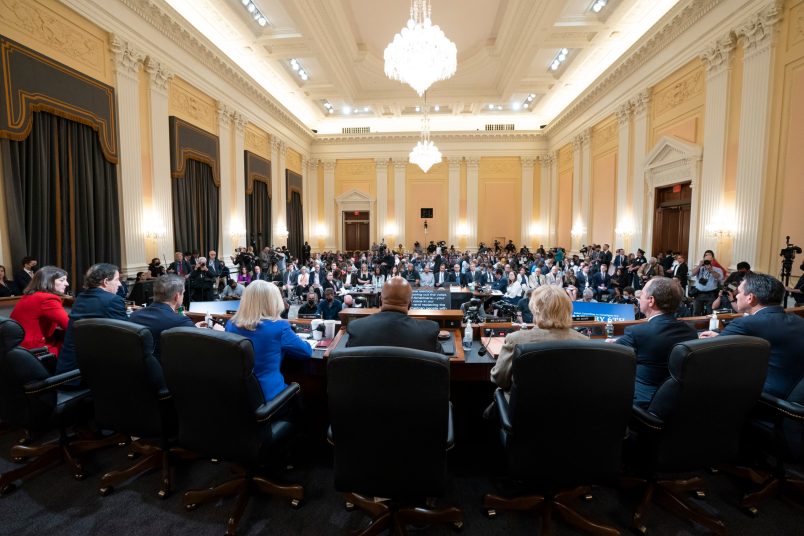We’ve been wondering for months whether the Jan. 6 committee will understand the Jan. 6 insurrection as a one-day spasm of violence, or the culmination of months of lies, provocation and planning from Donald Trump and his close associates.
From the beginning of Thursday’s hearing, it was clear the committee’s theory of the case is that it was a sweeping, sophisticated, and planned conspiracy to subvert the 2020 election.
Chair Bennie Thompson (D-MS) and Vice Chair Liz Cheney (R-WY) discussed the attack as part of a months-long scheme by Trump to steal a second term in office, one that included failed litigation, lies from Trump to his base, pressure campaigns against DOJ officials and the then-Vice President, and even a refusal by Trump to dispatch help to the Capitol in the middle of the attack.
Cheney said Trump’s plot to steal power was part of a “sophisticated seven-part plan” he oversaw.
The committee telegraphed that it will spend the planned series of six hearings to lay out the whole scope of this plot:
Trump Knew The Big Lie Was A Lie
The committee moved quickly to establish that Trump knew he lost the election. Quoting Trump campaign advisors, then-Attorney General Bill Barr and even the President’s daughter Ivanka Trump, Cheney previewed evidence that Donald Trump was well-aware that he’d lost the election — and nonetheless spent weeks organizing to remain in power and defy the will of the American people.
Trump Perpetuated The Big Lie
From there, the vice chair worked gradually through the steps of the conspiracy: Trump spent millions of dollars in campaign ads and sent endless tweets to convince his followers that the election had been stolen — even as he himself allegedly knew the truth. He pursued frivolous lawsuits that were laughed out of court, and which resulted in the suspension of the law license of his personal lawyer, Rudy Giuliani.
Trump Tried To Use The Executive Branch To Overturn The Election
When the courts failed him, Trump turned to the executive branch, Cheney explained, scheming to replace Justice Department officials with someone who would be willing to release a proposed letter announcing “significant concerns” with the election results, even though in reality there were none.
She displayed a quote from Richard Donoghue, then the acting deputy attorney general, who said what Trump wanted could have “tremendous constitutional, political and social ramifications for this country.” Donoghue added separately that the proposed letter would be “nothing less than the United States Justice Department meddling in the outcome of an election.”
With his options dwindling, Cheney said, Trump sought to pressure Vice President Mike Pence to refuse to count electoral votes — which Pence rejected. Pence’s chief of staff, Marc Short, testified that Pence’s “fidelity to the Constitution was his first and foremost oath.”
Cheney also noted Trump’s effort to pressure Georgia’s secretary of state to “find” the votes necessary for him to win, as well as the effort to have Trump’s supporters to submit fraudulent elector slates in swing states — further evidence of the wide-ranging conspiracy.
Trump’s Call To Come To DC On Jan. 6
None of this worked. But Trump persisted, calling his supporters to Washington, D.C. for a protest — “will be wild!” Trump tweeted, shortly after meeting with Michael Flynn, Sidney Powell, Rudy Giuliani and others in a White House huddle that included a discussion of potentially seizing voting machines around the country.
Trump knew just how “wild” the protest would get, Cheney asserted, with the White House receiving reports that “elements in the crowd were preparing for violence at the Capitol.” Steve Bannon, Trump’s former campaign chairman, said the day before the attack that “all hell is going to break loose tomorrow.”
Not only did he know, Cheney argued that the election had been fair, and also that members of his own administration were resisting his effort to have them intervene to steal the election — Trump also knew that the protest he summoned on Jan. 6 would truly be “wild” and violent.
Trump Watched The Capitol Attack And Did Nothing
Trump watched from the White House as the mob stormed the the Capitol: The violence that he had summoned to Washington, D.C. was on full display, being broadcast live on television.
And yet Trump did nothing, resisting calls to intervene.
Cheney promised a half dozen White House staff who were in the West Wing that day, and who she said would provide testimony on what Trump did and failed to do during those crucial hours.
But Trump didn’t just do nothing for several hours as the attack raged on — Cheney said that he even commented favorably upon it.
As rioters chanted “Hang Mike Pence,” she said, witnesses say Trump responded with the sentiment: “Maybe our supporters have the right idea — Mike Pence deserves it.”
The narrative laid out by the committee vice chair — of Trump’s knowing violation of the will of the American people, and his knowing cultivation of an attack on Congress — is an early preview that the committee is taking the long view: This wasn’t about one day, but months of steady planning to subvert democracy.







I hope the committee members will in future refer to Trump’s disinformation as disinformation, not misinformation. They are calling some lies lies.
Please oh please let these hearings be a big step in the right direction for this country.
Trump’s head must be exploding!
I went outside to see if I could hear anything, and sure enough, there was a constant but slow series of popping sounds. Like melon-sized gourds emptying the contents from their hardened shells. It was beautiful.
I’m starting to wonder if Garland might issue an indictment of Trump after these hearings. I can dream, can’t I?